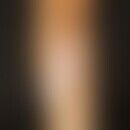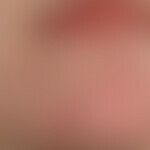Synonym(s)
Occurrence/EpidemiologyThis section has been translated automatically.
In about 20% of the male LS collectives as well as in about 40% of the female collectives, additional extragenital LS foci are found.
The isolated occurrence of an extragenital lichen sclerosus can be expected in about 6% of the entire LS collective.
ClinicThis section has been translated automatically.
- Clinically there are mostly disseminated or also grouped, white or grey-brown, about 0.2-0.5 cm large, but also spots and plaques confluent to larger, map-like areas with atrophic parchment-like surface. Typical are red borders of the foci (signs of underlying inflammation). Band-like hyperpigmentations are also found in the border area of the lichen sclerosus. Less frequent is a lesional blistering (see figure). Almost pathognomic are lesional haemorrhages, which are found in different shades of red (light red, deep red or reddish brown) depending on the duration of the lesion. Very rare is an infestation of the oral mucosa.
- Special forms: An intralesional hemorrhagic component is caused by secondary (often traumatically induced) haemorrhages in the area of the lichen sclerosus. In this "bradytrophic" zone, blood is broken down very slowly, so that bleeding can be detected over several weeks.
- The extragenital lichen sclerosus can occur together (possibly in combination with other autoimmune diseases, e.g. Hashimoto's thyroiditis) with vitiligo (Lee H et al. 2014; Kim YG et al. 2015)
You might also be interested in
Differential diagnosisThis section has been translated automatically.
Lichen planus: the typical diagnostic pathfinding red tone of the lichen planus effect is missing.
Vitiligo: mostly bizarre limitation; no induration of the lesions palpable; no perilesional red tone.
Morphea (circumscribed scleroderma): mostly fixed induration of the areas. in individual cases histological clarification
Note(s)This section has been translated automatically.
For further data and illustrations see below. lichen sclerosus
LiteratureThis section has been translated automatically.
- Eisendle K et al (2008) Possible role of Borrelia burgdorferi sensu lato infection in lichen sclerosus. Arch Dermatol 144: 591-598
- Hallopeau FH (1887) Du lichen plan, et particulièrement de sa forme atrophique. Union médicale (Paris) 43: 729-733
- Kim YG et al (2015) Colocalization of nonsegmental vitiligo and extragenital lichen sclerosus in a45-year-old
female patient with Hashimoto's thyroiditis. J Dermatol 42:333-334. - Kreuter A et al (2013) Association of autoimmune diseases with lichen sclerosus in 532 male and female patients. Acta Derm Venereol 93:238-241
- Lacarrubba F et al (2015) Extragenital lichen sclerosus: clinical, dermoscopic, confocal microscopy and histologic correlations. J Am Acad Dermatol 72 (1 Suppl): S50-52
Lee H et al (2014) Segmental vitiligo and extragenital lichen sclerosus etatrophicus
simultaneously occurring on the opposite sides of the abdomen. AnnDermatol
26:764-765- Lutz V et al (2011) High frequency of general Lichen sclerosus in a prospective series of 76 patients with morphea. Arch Dermatol 2011: 305
- Paolino G et al (2013) Lichen sclerosus and the risk of malignant progression: a case series of 159 patients. G Ital Dermatol Venereol 148:673-678
Patel B et al(2015) Extra genital lichen sclerosus et atrophicus withcutaneous
distribution and morphology simulating lichen planus. Indian JDermatol
60:105
Disclaimer
Please ask your physician for a reliable diagnosis. This website is only meant as a reference.
































